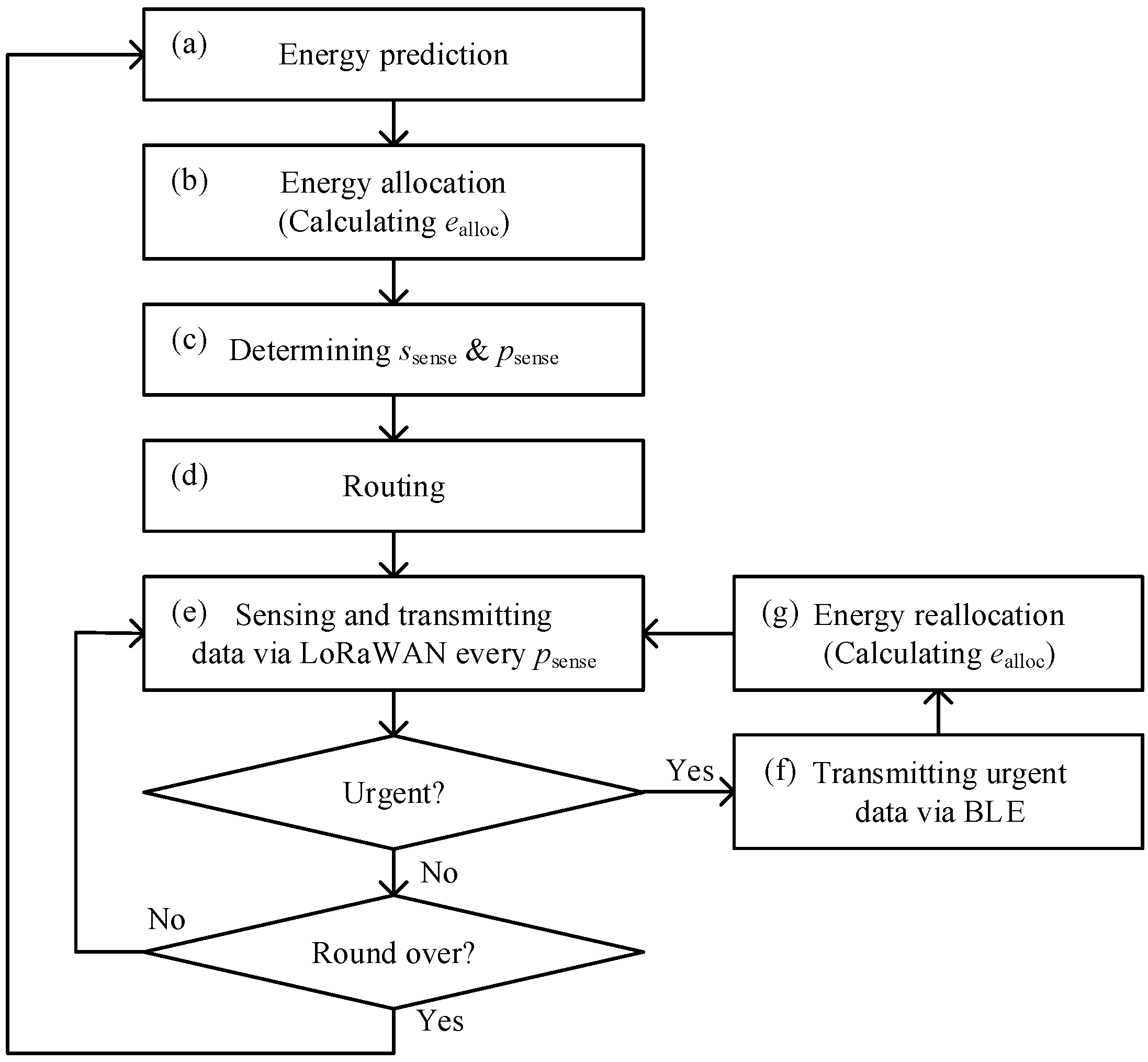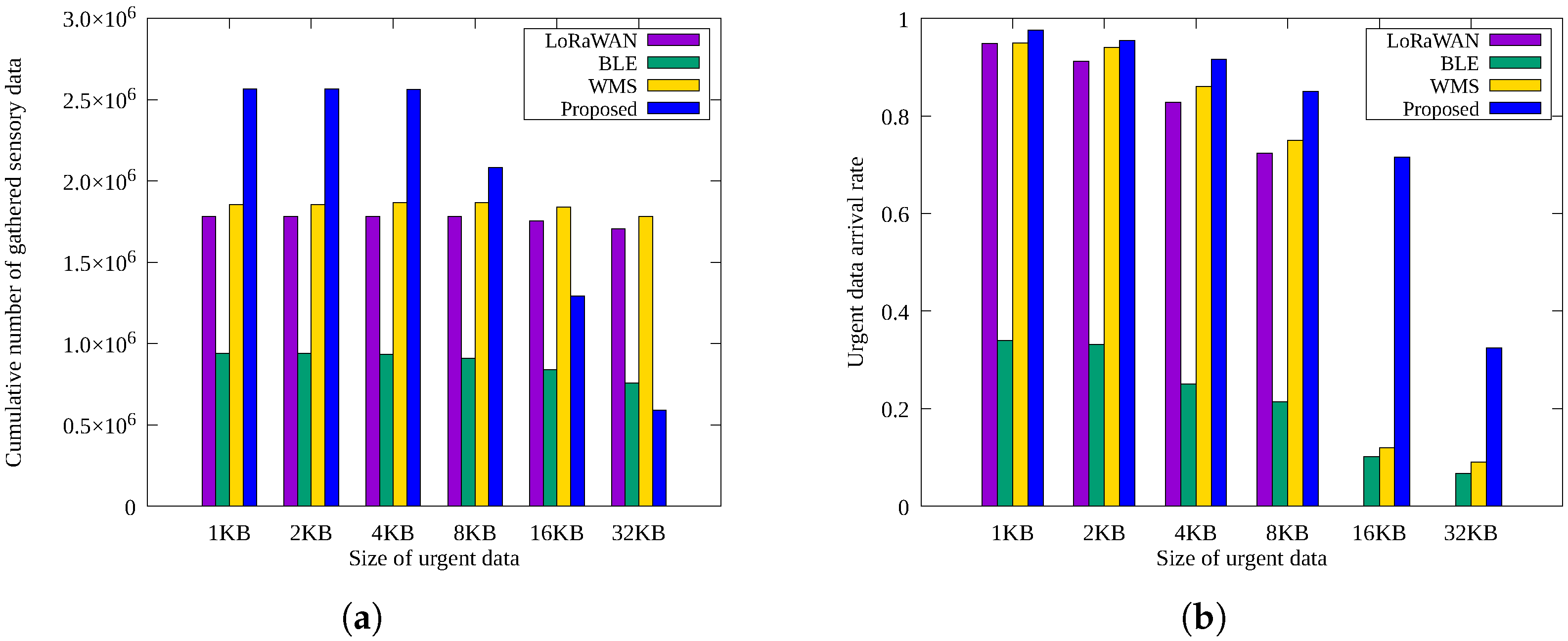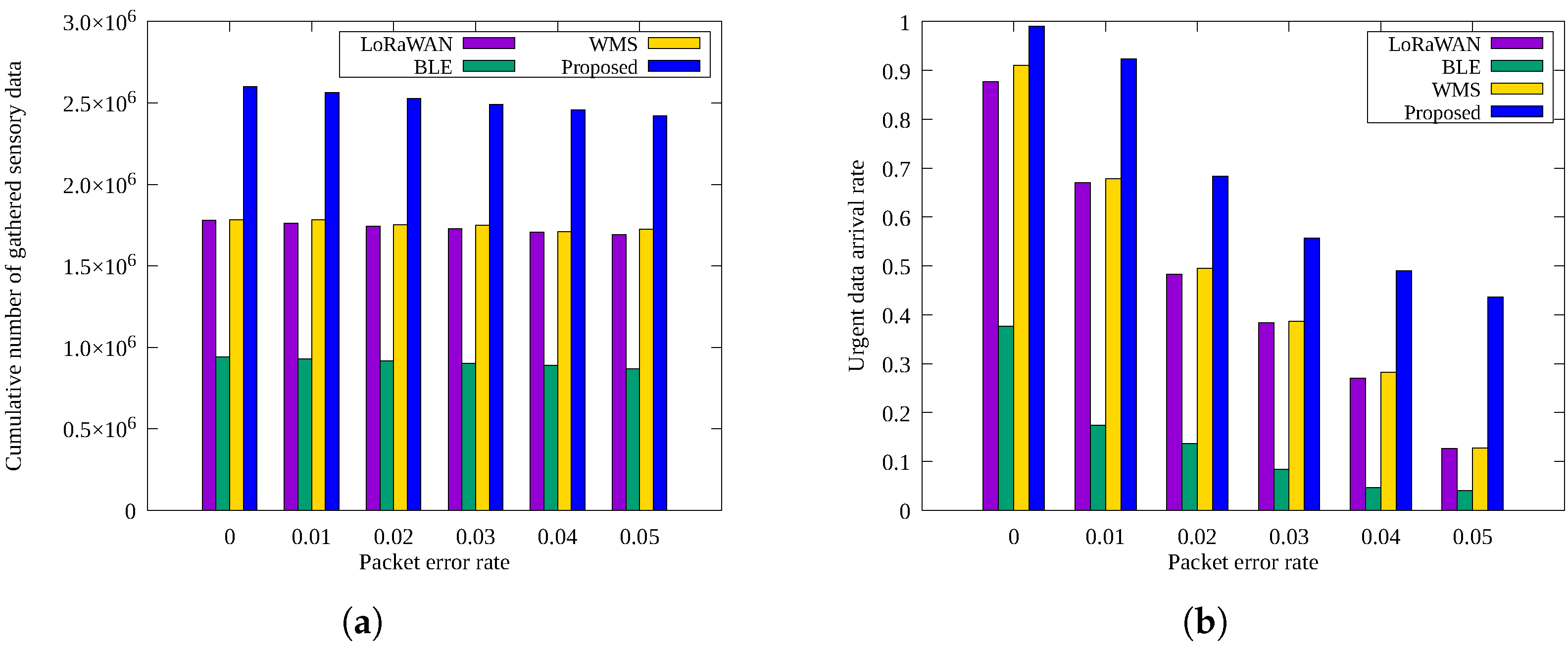Dual-Mode Data Collection for Periodic and Urgent Data Transmission in Energy Harvesting Wireless Sensor Networks
Abstract
1. Introduction
2. Related Work
3. Dual-Mode Data Collection for Periodic and Urgent Data Transmission
3.1. Overall System Operation
- (a)
- Predict the amount of energy harvested at the beginning of each round using the energy harvesting prediction scheme [28].
- (b)
- Determine the amount of energy to be allocated for usage in the current round by employing the energy allocation scheme [14].
- (c)
- Within , determine the maximum size of sensing data and sensing interval using the method described in Section 3.3.
- (d)
- Perform routing to determine the path to transmit urgent data via BLE using the modified minimum depth tree (MDT) algorithm described in Section 3.4.
- (e)
- Collect and transmit sensing data every .
- (f)
- On occurrence of urgent data, transmit it through the determined route in (d).
- (g)
- To ensure balanced energy consumption over time, sensor nodes that have transmitted urgent messages reallocate their energy as in (b).
3.2. Energy Prediction and Allocation of a Sensor Node
3.3. Sensing Period Determination
3.4. Routing for Urgent Data
- The sink node generates and broadcasts a route message, setting HOP to 0 and FROM to its own ID.
- Nodes receiving the route message act based on the following rules:
- (a)
- If receiving the message for the first time in the current round, the node sets the message’s HOP to its .
- (b)
- If the node has already determined its but receives another message, it updates as the message’s if its value is greater than the message’s .
- (c)
- If the node updates its route, it generates a new route message with its and ID, and broadcasts it.
- The routing process concludes once no further route messages require processing.
3.5. Sensor Node Operation for Urgent Data
- Node with ID i broadcasts an urgent message to their neighbor nodes. In the urgent message, SRC and FROM contain its ID, SEQ contains the urgent event number, HOP contains its , and EALLOC contains its .
- A receiving node examines the SRC and SEQ fields to check if the message is a duplicate. The node then decides whether to relay the message based on the following conditions:
- (a)
- If the message has already been received, or if the HOP is greater than its own , the node ignores the message.
- (b)
- If the message is new, but the HOP is equal to , the message is sent by its sibling. In this case, if its is less than or equal to EALLOC, it ignores the message because its energy is relatively low to maintain energy balance.
- (c)
- If the message is new, but the HOP is smaller than , the message is ignored because it is transmitted in a direction away from the sink node.
- (d)
- Otherwise, the node broadcasts a new urgent message with its own ID, , and in the FROM, HOP, and EALLOC field, respectively.
- This process repeats until all messages are sent.
- All nodes that sent the urgent message perform energy allocation to recalculate .
| Algorithm 1 Urgent data transmission process |
Require: Node senses urgent situation.
|
4. Performance Evaluation
4.1. Performance Comparison by Number of Nodes
4.2. Performance Comparison by Urgent Message Size
4.3. Performance Comparison by Packet Error Rate
4.4. Performance Comparison by Urgent Message Generation Period
5. Conclusions
Funding
Institutional Review Board Statement
Informed Consent Statement
Data Availability Statement
Conflicts of Interest
Abbreviations
| BLE | Bluetooth Low Energy |
| LoRa | Long Range |
| LoRaWAN | Long Range Wide-Area Network |
| MDT | Minimum depth tree |
| ToA | Time on Air |
| WSN | Wireless sensor network |
| WPT | Wireless power transfer |
| RF | Radio frequency |
References
- Shahraki, A.; Taherkordi, A.; Haugen, Ø.; Eliassen, F. Clustering objectives in wireless sensor networks: A survey and research direction analysis. Comput. Netw. 2020, 180, 107376. [Google Scholar] [CrossRef]
- Temene, N.; Sergiou, C.; Georgiou, C.; Vassiliou, V. A survey on mobility in Wireless Sensor Networks. Ad Hoc Netw. 2022, 125, 102726. [Google Scholar] [CrossRef]
- Sahar, G.; Bakar, K.A.; Rahim, S.; Khani, N.A.K.K.; Bibi, T. Recent advancement of data-driven models in wireless sensor networks: A survey. Technologies 2021, 9, 76. [Google Scholar] [CrossRef]
- Akyildiz, I.F.; Su, W.; Sankarasubramaniam, Y.; Cayirci, E. Wireless sensor networks: A survey. Comput. Netw. 2002, 38, 393–422. [Google Scholar] [CrossRef]
- Arampatzis, T.; Lygeros, J.; Manesis, S. A survey of applications of wireless sensors and wireless sensor networks. In Proceedings of the 2005 IEEE International Symposium on Intelligent Control, Mediterranean Conference on Control and Automation, Limassol, Cyprus, 27–29 June 2005; IEEE: Piscataway Township, NJ, USA, 2005; pp. 719–724. [Google Scholar] [CrossRef]
- Ijemaru, G.K.; Ang, K.L.M.; Seng, J.K. Wireless power transfer and energy harvesting in distributed sensor networks: Survey, opportunities, and challenges. Int. J. Distrib. Sens. Netw. 2022, 18, 15501477211067740. [Google Scholar] [CrossRef]
- Sharma, P.; Singh, A.K. A survey on RF energy harvesting techniques for lifetime enhancement of wireless sensor networks. Sustain. Comput. Inform. Syst. 2023, 37, 100836. [Google Scholar] [CrossRef]
- Sah, D.K.; Amgoth, T. Renewable energy harvesting schemes in wireless sensor networks: A survey. Inf. Fusion 2020, 63, 223–247. [Google Scholar] [CrossRef]
- Singh, J.; Kaur, R.; Singh, D. Energy harvesting in wireless sensor networks: A taxonomic survey. Int. J. Energy Res. 2021, 45, 118–140. [Google Scholar] [CrossRef]
- Williams, A.J.; Torquato, M.F.; Cameron, I.M.; Fahmy, A.A.; Sienz, J. Survey of energy harvesting technologies for wireless sensor networks. IEEE Access 2021, 9, 77493–77510. [Google Scholar] [CrossRef]
- Hao, S.; Hong, Y.; He, Y. An energy-efficient routing algorithm based on greedy strategy for energy harvesting wireless sensor networks. Sensors 2022, 22, 1645. [Google Scholar] [CrossRef]
- Sah, D.K.; Hazra, A.; Mazumdar, N.; Amgoth, T. An efficient routing awareness based scheduling approach in energy harvesting wireless sensor networks. IEEE Sens. J. 2023, 23, 17638–17647. [Google Scholar] [CrossRef]
- Navarro, M.; Liang, Y.; Zhong, X. Energy-efficient and balanced routing in low-power wireless sensor networks for data collection. Ad Hoc Netw. 2022, 127, 102766. [Google Scholar] [CrossRef]
- Noh, D.K.; Kang, K. Balanced energy allocation scheme for a solar-powered sensor system and its effects on network-wide performance. J. Comput. Syst. Sci. 2011, 77, 917–932. [Google Scholar] [CrossRef]
- Zhang, Y.; He, S.; Chen, J. Data gathering optimization by dynamic sensing and routing in rechargeable sensor networks. IEEE/ACM Trans. Netw. 2016, 24, 1632–1646. [Google Scholar] [CrossRef]
- Sharma, V.; Mukherji, U.; Joseph, V.; Gupta, S. Optimal energy management policies for energy harvesting sensor nodes. IEEE Trans. Wirel. Commun. 2010, 9, 1326–1336. [Google Scholar] [CrossRef]
- Daraghma, R.S.; Daraghmi, Y.; Daraghmi, E.; Fouchal, H.; Ayaida, M. Comparison of NB-IOT, Lora, and Sigfox IOT Protocols in a Wireless Sensor Network. Int. J. Commun. Antenna Propag. 2023, 13, 80–88. [Google Scholar] [CrossRef]
- Mowla, M.N.; Mowla, N.; Shah, A.S.; Rabie, K.M.; Shongwe, T. Internet of Things and wireless sensor networks for smart agriculture applications: A survey. IEEE Access 2023, 11, 145813–145852. [Google Scholar] [CrossRef]
- Truong, V.T.; Nayyar, A.; Lone, S.A. System performance of wireless sensor network using LoRa-Zigbee hybrid communication. Comput. Mater. Contin. 2021, 68, 1615–1635. [Google Scholar] [CrossRef]
- Bravo-Arrabal, J.; Zambrana, P.; Fernández-Lozano, J.J.; Gómez-Ruiz, J.A.; Barba, J.S.; García-Cerezo, A. Realistic deployment of hybrid wireless sensor networks based on ZigBee and LoRa for search and Rescue applications. IEEE Access 2022, 10, 64618–64637. [Google Scholar] [CrossRef]
- Leonardi, L.; Bello, L.L.; Patti, G. LoRa support for long-range real-time inter-cluster communications over Bluetooth Low Energy industrial networks. Comput. Commun. 2022, 192, 57–65. [Google Scholar] [CrossRef]
- Sisinni, E.; Depari, A.; Flammini, A.; Rinaldi, S.; Ferrari, P. Evaluating the joint use of LoRaWAN and Bluetooth mesh to improve survivability for critical sensor applications. IEEE Sens. J. 2024, 24, 22992–23003. [Google Scholar] [CrossRef]
- Ayele, E.D.; Das, K.; Meratnia, N.; Havinga, P.J. Leveraging BLE and LoRa in IoT network for wildlife monitoring system (WMS). In Proceedings of the 2018 IEEE 4th World Forum on Internet of Things (WF-IoT), Singapore, 5–8 February 2018; IEEE: Piscataway Township, NJ, USA, 2018; pp. 342–348. [Google Scholar] [CrossRef]
- Pérez, E.; Parada, R.; Monzo, C. Global emergency system based on WPAN and LPWAN hybrid networks. Sensors 2022, 22, 7921. [Google Scholar] [CrossRef] [PubMed]
- Yoon, I. Data acquisition control for UAV-enabled wireless rechargeable sensor networks. Sensors 2023, 23, 3582. [Google Scholar] [CrossRef]
- Ferreira, C.M.S.; Oliveira, R.A.R.; Silva, J.S. Low-energy smart cities network with LoRa and bluetooth. In Proceedings of the 2019 7th IEEE International Conference on Mobile Cloud Computing, Services, and Engineering (MobileCloud), Newark, CA, USA, 4–9 April 2019; IEEE: Piscataway Township, NJ, USA, 2019; pp. 24–29. [Google Scholar]
- Singh, R.; Birajdar, G.S.; Rashid, M.; Gehlot, A.; Akram, S.V.; AlGhamdi, A.S.; Alshamrani, S.S. Hybrid architectural network implementation to realize a fire evacuation path with 2.4 ghz zigbee and lora. Sustainability 2021, 13, 13238. [Google Scholar] [CrossRef]
- Cammarano, A.; Petrioli, C.; Spenza, D. Pro-Energy: A novel energy prediction model for solar and wind energy-harvesting wireless sensor networks. In Proceedings of the 2012 IEEE 9th International Conference on Mobile Adhoc and Sensor Systems (MASS), Las Vegas, NV, USA, 8–11 October 2012; IEEE: Piscataway Township, NJ, USA, 2012; pp. 75–83. [Google Scholar] [CrossRef]
- Melodia, T.; Pompili, D.; Akyildiz, I.F. Optimal local topology knowledge for energy efficient geographical routing in sensor networks. In Proceedings of the 23rd IEEE INFOCOM, Hong Kong, China, 7–11 March 2004; IEEE: Piscataway Township, NJ, USA, 2004; Volume 3, pp. 1705–1716. [Google Scholar] [CrossRef]
- Cheng, H.C.; Lin, F.Y.S. Minimum-cost multicast routing for multi-layered multimedia distribution. In Proceedings of the IFIP/IEEE International Conference on Management of Multimedia Networks and Services, San Diego, CA, USA, 3–6 October 2004; Springer: Berlin/Heidelberg, Germany, 2004; pp. 102–114. [Google Scholar] [CrossRef]
- Yi, J.M.; Kang, M.J.; Noh, D.K. SolarCastalia: Solar energy harvesting wireless sensor network simulator. Int. J. Distrib. Sens. Netw. 2015, 11, 1–10. [Google Scholar] [CrossRef]








| Parameters | Values |
|---|---|
| Number of nodes | 200 |
| Node density | 0.04 |
| Duration of a round | 1 h |
| Battery capacity | 110 mAh |
| Sensory data size | 20 bytes |
| Urgent data size | 8 kbytes |
| BLE data rate | 250 kbps |
| LoRaWAN data rate | 5.47 kbps |
| LoRaWAN spreading fector | 7 |
| LoRaWAN bandwidth | 125 kHz |
| Transmission power | 2 dBm |
| Sleep power | 3.3 µW |
Disclaimer/Publisher’s Note: The statements, opinions and data contained in all publications are solely those of the individual author(s) and contributor(s) and not of MDPI and/or the editor(s). MDPI and/or the editor(s) disclaim responsibility for any injury to people or property resulting from any ideas, methods, instructions or products referred to in the content. |
© 2025 by the author. Licensee MDPI, Basel, Switzerland. This article is an open access article distributed under the terms and conditions of the Creative Commons Attribution (CC BY) license (https://creativecommons.org/licenses/by/4.0/).
Share and Cite
Yoon, I. Dual-Mode Data Collection for Periodic and Urgent Data Transmission in Energy Harvesting Wireless Sensor Networks. Sensors 2025, 25, 2559. https://doi.org/10.3390/s25082559
Yoon I. Dual-Mode Data Collection for Periodic and Urgent Data Transmission in Energy Harvesting Wireless Sensor Networks. Sensors. 2025; 25(8):2559. https://doi.org/10.3390/s25082559
Chicago/Turabian StyleYoon, Ikjune. 2025. "Dual-Mode Data Collection for Periodic and Urgent Data Transmission in Energy Harvesting Wireless Sensor Networks" Sensors 25, no. 8: 2559. https://doi.org/10.3390/s25082559
APA StyleYoon, I. (2025). Dual-Mode Data Collection for Periodic and Urgent Data Transmission in Energy Harvesting Wireless Sensor Networks. Sensors, 25(8), 2559. https://doi.org/10.3390/s25082559






